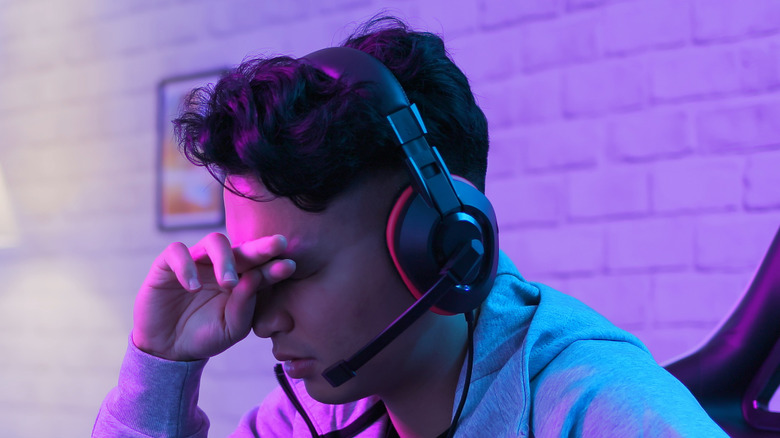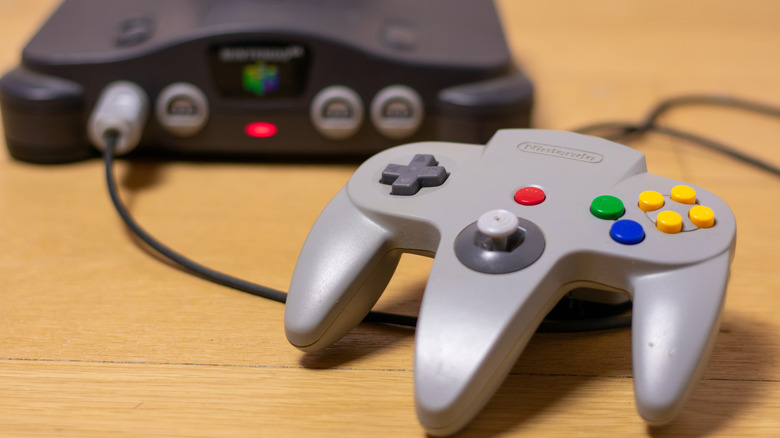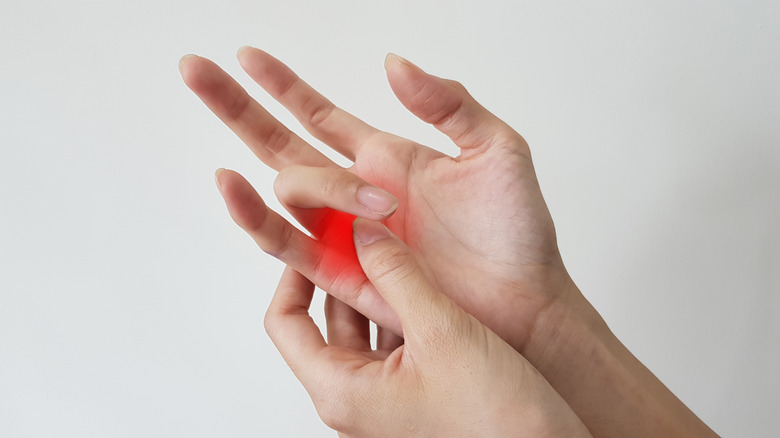Gaming Injuries Can Be Worse Than You Realized
Nobody likes getting hurt. Whether it's a stubbed toe or a dislocated shoulder, virtually everyone can agree that pain sucks, which is why people do almost everything to avoid injuries. Some create protective measures to defend their frail bodies, while others just replace injury-prone activities with safer hobbies. Video games might sound like a great alternative since they only involve pressing buttons on a controller to move characters around a screen. Nobody ever got injured doing that, right? Guess again.
Like every other worldly endeavor, gaming poses its own risks. While some of these potential issues are merely factors that add to an ever-increasingly sedentary lifestyle, others ironically pose the same threats as traditional sports and other sweat-fueled activities. For instance, while many athletes need surgery for injuries sustained on the gridiron, famous gamers like Matthew Perry have been admitted to the hospital for straining their thumbs playing too much "Fallout 3." There's more than one way to pull a muscle, and gamers like Perry are the lucky ones, as some injuries have resulted in far more grievous fates than mere surgery and bed rest.
Here's a small list of nasty injuries people have suffered from playing video games. But don't let this scare you too much. As with most things in life, an ounce of prevention is worth a pound of cure.
Dishonorable Mention: Bad controller design
Every game console's design needs to walk a tightrope between aesthetics and ergonomics. The PlayStation 5, for example, sports massive fins and vents to ensure the console's components don't cook themselves, while the Virtual Boy infamously caused eye strain and back aches. Developing a good controller is a part of that tightrope walk. Who wants a peripheral that injures them?
When the Atari 2600 first launched, the concept of video game peripherals was fairly new. The console was bundled with one of the first joysticks ever produced, and while the design was iconic, it was also rough enough to damage palms. Players who gripped the joystick too tightly for too long reportedly suffered "Atari Skinning" — the skin on their palms broke down and became vulnerable to infection. It also didn't help that these joysticks were bacteria magnets.
While the Atari joystick is one of the first instances of palm-pulverizing peripherals, it isn't the most famous. Thanks to "Mario Party," that dishonor goes to the Nintendo 64. Many mini-games in that title require players to quickly rotate the analogue stick, which has resulted in countless blisters and friction burns. In some instances, children needed tetanus shots. These injuries were so widespread that Nintendo spent an estimated $80 million on protective gloves affected players could request for free (per BBC News). However, while much of the game's palm-busting infamy was caused by the N64 analog stick's design, some blame lies with the control scheme. When "Mario Party" mini-games were ported to 2021's "Mario Party Superstars," Nintendo asked players to rotate the joysticks with their thumbs and fingers, not their palms.
Early generations of gamers suffered through hand injuries so contemporary analog sticks could become more refined and safer.
Carpal tunnel syndrome
Humans are some of the most dexterous animals on Earth thanks to our fingers, hands, and wrists. These evolutionary marvels can manipulate virtually any object and can function in a variety of positions. However, certain positions put unnecessary pressure on muscles and nerves, and if that pressure subsists for too long, a debilitating injury isn't far behind.
The advent of computers and video games resulted in an uptick of carpal tunnel syndrome. Many finger movements associated with keyboards, mice, and controllers pinch the median nerve. Repeat these movements over a long period of time, and fingers start to feel numb or tingly. Eventually, the tendons become inflamed, which puts even more pressure on the nerve. In mild cases of carpal tunnel syndrome, a brace or splint keeps the tunnel straight, which opens it up. Wrist exercises and/or a quick shot of cortisone can also bring down inflammation. But when all else fails, doctors must surgically relieve pressure.
Carpal tunnel syndrome is especially prevalent in esports players, given the rapid hand movements they use during practices and competitions. This injury has sidelined professional esports champions such as Issa "Issa" Rahim, who was only 19 when he was forced to call it quits (per Ginx).
Because carpal tunnel syndrome is not exclusive to gamers, everyone who spends a significant amount of time on the computer — either for work or games — should keep their wrists nice and limber. You can't type out an important budget report if your fingers are numb any more than you can win a match of "Street Fighter."
Trigger finger/Gamer's thumb
In the olden days, parents liked to tell children that their faces would get stuck if they grimaced too much. Worldly experience has taught us that only medical conditions such as tetanus and strokes can freeze faces, but parents were ironically not as far off as you might think. Turns out playing video games for too long can leave your fingers stuck.
Since the body is full of tendons that connect muscles to bone, conditions such as tendonitis — the inflammation of tendons or the sheaths surrounding them — can strike anywhere. Two versions prevalent in avid video game users are Gamer's Thumb and Trigger Finger, also known as de Quervain's tenosynovitis and stenosing tenosynovitis, respectively. Both conditions are caused by repetitive motions, such as frequently pressing controller buttons for long periods of time, and narrow the amount of space tendons have within their sheaths.
While Gamer's Thumb and Trigger Finger result in pain and swelling, they can also limit and restrict digit movement. Gamer's Thumb makes it difficult to move your thumb, while Trigger Finger outright locks a finger in a bent position not unlike one used when pulling a trigger (hence its name). Studies available at sites such as PubMed and NCBI demonstrate a connection between these injuries and prolonged gaming sessions, but these issues can also strike people who spend too much time texting on smartphones. Professional eSports competitors such as Thomas "ZooMaa" Paparatto have retired due to thumb injuries that feature many of the telltale signs of Gamer's Thumb.
If your fingers hurt for any reason, stop what you're doing and rest for a bit. Video games aren't worth a frozen digit.
Tennis elbow/Mouse elbow
The longer you move a body part without rest, the more likely you will inflame the associated tendons. That's why you hear so many stories of tennis players and other athletes suffering from tennis elbow; they swing their arms so much that the tendons in their elbows swell. However, despite the name, tennis elbow isn't exclusive to tennis players, let alone athletes. Many gamers also suffer from a similar condition.
Depending on who you ask, mouse elbow is the same as tennis elbow. Both injuries are brought on by repetitive motions that overload elbow tendons, which causes pain that can spread from the elbow to the wrist. Some doctors believe mouse elbow is actually a tendinopathy, which is the result of collagen degeneration in the tendon, not tendon inflammation (per Esports Healthcare). This deterioration supposedly makes tendons change from organized bundles to knotted masses, causing the pain. Tendinopathy might even lead to tendonitis.
One recent study concluded that esports participants are at increased risk of suffering from tendinopathy due to repetitive motions associated with gaming. While the paper admitted that one study is far from definitive evidence, DarkZero Esports CEO Zach Matula told PCGamer that many of his players suffer from carpal tunnel syndrome and tennis elbow. In other words, the rigorous mouse scrolls, keyboard pressing, and button mashes of esports may very well lead to tendonitis/tendinopathy.
At the end of the day, it doesn't matter if mouse elbow is the result of inflamed tendons or collagen-deficient tendons; all that matters is proper elbow maintenance to keep tendons happy and injury-free.
Collapsed lung
Most gaming-related injuries only become problematic if you ignore the warning signs. Even then, they are rarely life-threatening. However, some problems can pop up without warning — and claim lives just as quickly. One such injury is a collapsed lung, which seems like the last catastrophe that would strike gamers, but it's more widespread than you think.
A collapsed lung, better known as pneumothorax, occurs when the lung caves in and all the air stored inside rushes into the surrounding area. This devastating event causes intense chest pain, shortness of breath, and death if left untreated. Normally, you are only at risk if you have lung disease or suffered a chest injury, but a shocking number of esports players are learning their bad habits can also result in a collapsed lung.
Kotaku once reached out to medical professionals and learned that the esports lifestyle is the perfect breeding ground for collapsed lungs. One of these professionals, Counter Logic Gaming's physical performance head Matthew Hwu, claimed that collapsed lungs tend to strike thin individuals with sedentary lives and poor posture. Another doctor, physical therapist Caitlin McGee, stated that poor posture and "bad breathing habits" also open the door for collapsed lungs. Many famous esports competitors have been hospitalized for lungs that suddenly collapsed. These include Song "Janus" Jun-hwa of Luxurywatch Blue, Lukas "gla1ve" Rossander of the Copenhagen Wolves, and Hai Du Lam of Cloud 9.
While the notion of suddenly losing a lung while gaming is beyond terrifying, apparently the key to preventing that condition is proper posture and breath control. So just remember to breathe and sit up straight, and you will probably be fine.
Deep vein thrombosis
Blood clots are a normal part of the human body, and once the clot has served its purpose, it usually dissolves. But sometimes these clots refuse to dissipate and clog a vein or artery. This is known as thrombosis and is rarely seen in anyone under 50 (per Healthline). However, one kind of vein clot is becoming increasingly prevalent in the younger generation.
Deep vein thrombosis, as its name suggests, is a blood clot in the leg's deep veins. While many cases result in painful and swollen legs, some victims are asymptomatic and unaware they have a clog. Deep vein thrombosis can form in anyone predisposed to blood clots, but they are far more common in people who don't move their legs for extended periods of time (i.e., gamers and esports players).
According to one study and a literature review, both published on NCBI, extended gaming sessions pose an increased risk of developing deep vein thrombosis. Moreover, while this condition is dangerous by itself — one gamer was paralyzed from the waist down after playing for 20 hours — thromboses pose an even bigger risk when the clot breaks free and lodges in the heart or lungs. This condition, known as a pulmonary embolism, is often fatal. And, while it's considered "rare" for a deep vein clot to graduate into an embolism, many gamers have suffered fatal embolisms linked to deep vein thrombosis brought on by prolonged stationary gaming sessions.
Depending on their lifestyle, gamers as young as 12 can develop fatal blood clots in as little as three hours. This knowledge shouldn't scare you off gaming, just reaffirm the importance of stretching your legs every now and then.
Retinal artery occlusion
Parents used to warn children they would go blind if they sat too close to the TV. While older cathode ray tube TVs can give you an undesirable blast of radiation if you sit too close to them, television screens (especially modern ones) probably won't ruin your vision, no matter how close you stare at them. Looking at screens for as long as you want, however, is another matter.
In 2017, a Chinese woman went blind in her right eye after spending over 20 hours playing a mobile game. You might assume it's a stretch to link this single occurrence to video games, but in 2019, a Chinese man also went blind in his right eye after playing a mobile game in the dark — and gaming habits might have played a part.
Both victims suffered a retinal artery occlusion, which occurs when the artery that carries oxygen to the retina is blocked. Although retinal artery occlusions usually crop up in the elderly, the aforementioned victims were pretty young. Moreover, the Chinese man's doctor reportedly treats 20 youthful patients a month for phone-caused retinal artery occlusion (per SCMP).
That might seem like inarguable evidence that video games are to blame, but not all physicians are convinced. One doctor writing for Aberdeen News stated there are too many potential risk factors to be sure. The victims could have had diabetes, high blood pressure, or an artery disease — the eye strain from gaming could simply have been the final straw.
The link between gaming and retinal artery occlusion is still tenuous, but audiences should treat these stories as cautionary tales: Favoring any activity or hobby over one's health — including video games — is a recipe for disaster.
Heart attacks
Of all the maladies that can strike without warning, heart attacks are one of the worst. Sudden intense pain in the chest, shortness of breath, and a cold sweat are telltale signs. If not treated immediately, a heart attack can prove fatal. However, not all heart attacks are the same — some victims only experience minor pain, or none at all. But heart attacks are extra-dangerous for gamers because the risk factors accurately describe far too many of them.
Family history can determine the likelihood of a heart attack, but a sedentary lifestyle, high blood pressure, and high cholesterol also increase one's chances. Unfortunately, many gamers lead sedentary lives, and heart attacks have claimed too many in the midst of lengthy gaming sessions. For instance, a 32-year-old Taiwanese man died after a 3-day gaming session — he wasn't discovered for several hours, despite dying at an internet cafe — and not even youth can save victims. Children as young as 12 and 16 have died while gaming due to heart attacks.
Ironically, while too much gaming can cause a heart attack, some studies show that gaming in moderation can actually prevent them. The Your Body on eSports project, for instance, found that games such as "Counter-Strike" and "Apex Legends" reduced stress and blood pressure. However, not everyone can benefit from a few rounds of competitive video games. A different study concluded that although video games only result in a minor change in cardiovascular activity, that alteration is more than enough to threaten the lives of people with a pre-existing cardiovascular disease.
Upper crossed syndrome
How do you concentrate on something you think deserves your undivided attention? Gamers tend to lean forward and hunch their shoulders. Common knowledge says this posture increases reaction time and attentiveness, but according to medical professionals, this posture only increases back pain and body deformation.
When gamers lean forward for extended periods of time, they overuse their back, shoulder, and neck muscles at the cost of other upper-body muscles. This misshapes all muscles involved and results in what is called upper crossed syndrome. Common symptoms include constant pain and stress in the neck, shoulders, and back, all of which are usually treatable with physical and chiropractic therapy, as well as regular exercise. Of course, not slouching while gaming also helps.
While no esports champions have retired due to upper crossed syndrome (yet), the brunt of the condition's damage isn't supposed to crop up until later in life. Kentucky-based chiropractor Adam Fields told Vice that most of his clients are gamers, and yes, many of them suffer from upper crossed syndrome. The majority of his patients see him up to four times a week. According to Fields, gamers who suffer from the injury are more likely to develop a hunchback in their later years, among other issues, if they don't correct the problem while they're young.
Out of all the potential injuries that can affect gamers — and are exacerbated by their lifestyle — upper crossed syndrome is probably one of the easiest to control. This might seem like trite advice, but it's true what mothers and teachers say: sitting up straight is good for your back.










